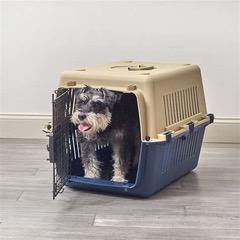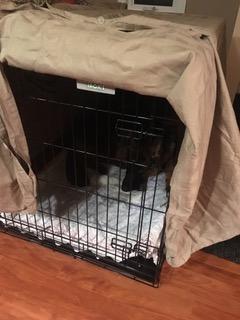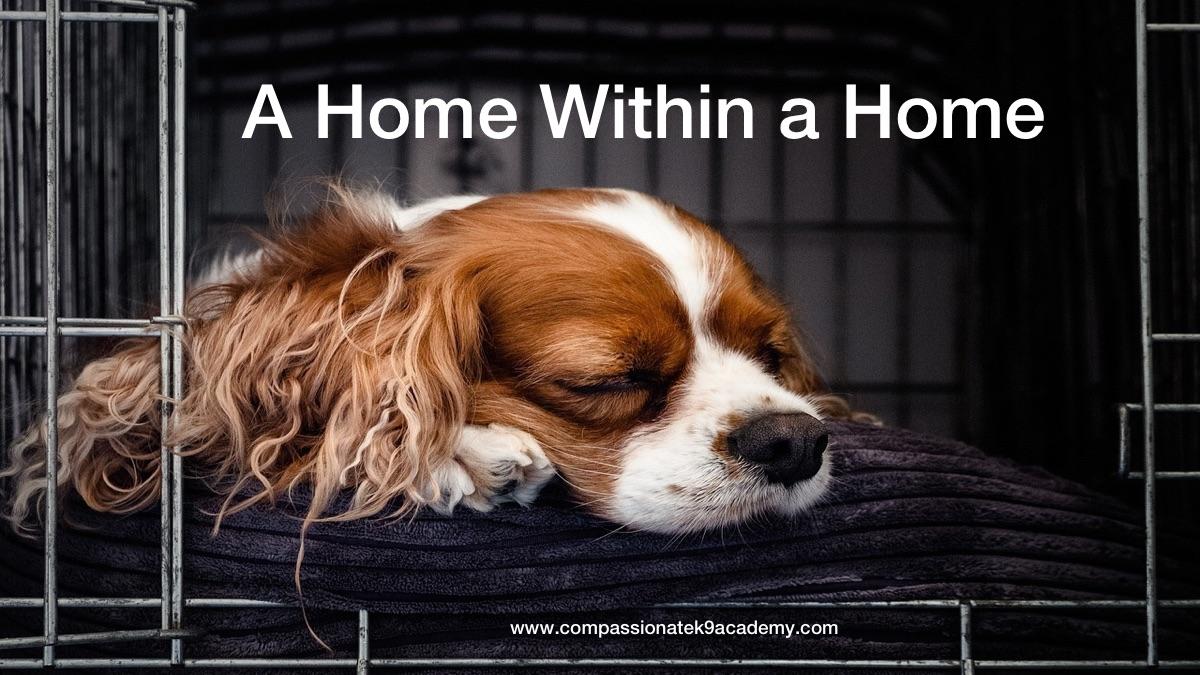Crate training is the process of teaching your puppy to accept a crate as a familiar and safe place.
Canines are den animals and a crate is a modern den—a dog’s personal, portable bedroom that he can retire to.
A crate makes house training easier, prevents destructive chewing and furnishes your dog with a safe place when alone or recovering from an injury or medical procedure. It also provides safety and prevents motion sickness when your dog is travelling in your vehicle or on an airplane.
A crate should always be associated with something pleasant, therefore, crate training should be introduced gradually in small steps.
To train your dog to feel comfortable in a crate can take days or weeks, depending on your puppy’s age, temperament and past experiences.
To make it more inviting, outfit the crate with a soft bed or mat and a plushy toy. To ease your puppy’s anxiety about being in the crate, you could play soft music and give him an interactive food dispensing toy.
The goal is to create a space he seeks out when he needs a break from the hustle and bustle of family life.
Types of Crates
Numerous crates are available on the market. Depending on your specific needs and the type of dog, the following are my suggestions:
Plastic or aluminum, airline-approved crates provide coziness in your home and are perfect when travelling with your dog by car or plane.

Wire crates are recommended for large breed puppies. They are durable and collapsible and allow for a full 360-degree airflow. They can be ordered with a divider panel and gradually expanded as your puppy grows.
Covering the top of the crate with a towel or blanket gives your dog a feeling of being in a den.
Soft fabric crates are suitable for miniature adult dogs who are already crate trained. These are perfect for air transport as an under-seat carry on.
Furniture style crates are functional and decorative but pricey.
Any crate you use needs to be large enough to permit your dog to comfortably enter, stand, turn around and sleep in his favourite position. Don’t buy one too big or your puppy will use part of it as his toilet area.
Make the crate comfortable by equipping it with a washable dog bed, small bath mat or pad. If your puppy destroys the pad and/or pees on it, remove it.

Some double-coated long haired puppies find the coolness of their bare crate floor preferable in the summer time.
During the day, keep the crate in an environmentally comfortable location—not in direct sunlight or by an open window. Keep it in an area of your home where the family spends a lot of time.
Move the crate into your bedroom during the night so you can hear when he has to go out.
Getting Your Puppy Used to the Crate
Gradually socialize your puppy to the crate by making it a positive experience.
—Step One. Start by tying the door open and tossing treats nearby. Then, toss treats just inside the door and finally toward the back of crate.
Keep the door propped open securely so it doesn’t accidentally hit and scare your puppy when he is going in and out of the crate. Feed meals inside the crate for the first dozen or so times to form a positive association in your dog’s mind.
—Step Two. After a few days of training step one, add a cue like “go to bed” and toss a treat inside. Praise your puppy for going in to eat the treats, then encourage him to come back out. Repeat this several times until the puppy enjoys going in and out of the crate.
When your puppy goes into the crate on his own and without a cue, give him a “jackpot” of treats.
—Step Three. Cue your puppy into the crate and close the door briefly while he is inside to desensitize him to the door. While he is in there, drop a few treats inside or feed him his meal. Sit quietly close by for 10 minutes and then let your puppy come out.
—Step Four. Repeat step three but instead of sitting close by, walk around the room. Stay in sight of your puppy and return to the crate to reward him with a treat as long as he remains quiet.
—Step Five. Begin varying the duration the puppy is crated with the door being closed while you do something in your home. Return to the crate and periodically drop a few, high-value treats inside.
—Step Six. Crate your puppy for 5-20 minutes and leave the house. Don’t leave a collar on your puppy while in the crate as it can get caught and strangle your dog.
Don’t make a fuss of leaving, just say: “I will be right back!” To keep your puppy calm in his crate while you are gone, provide him with a safe, food-stuffed toy such as a “Kong, a Busy Buddy or a Licki-Mat.”
Depending on what toy you use, stuff or spread pure, canned pumpkin, protein-based baby food, plain yoghurt, tiny liver treats, etc. Freezing these food toys will extend your dog’s licking pleasure.
When you return, keep your greeting “low-key.”
If your puppy hears you and starts barking or whining before you open the house door, don’t enter. Wait until there is a pause in his vocalization, then go in, let him out and reward him with a yummy treat.
Things Not to Do With a Crate
The crate should never be used as a punishment, and your dog should never be forced into it for unruly behaviour; it’s also not appropriate for long term confinement.
During the day, a puppy should never be crated longer than two hours at a time and an adult dog not more than six hours without a potty and exercise break.
If you’re absent from your home longer than this, there are resources available:
- Hire a dog walker.
- Have a family member or neighbour give the dog a potty and exercise break.
- Use a doggy daycare (this is not recommended for young puppies under the age of six months).
Crate training your puppy takes time and patience but is invaluable to make him feel comfortable and safe.
It also assists when you need to temporarily confine your dog during veterinarian or grooming visits as well as for the reasons mentioned above.

